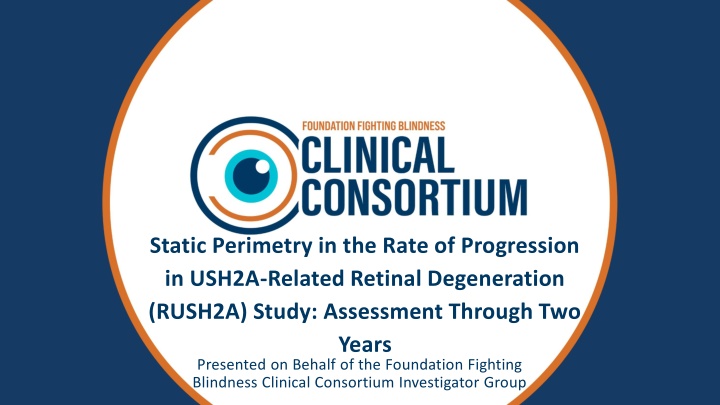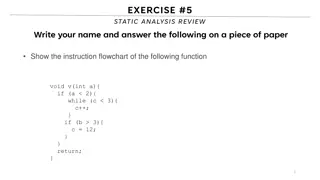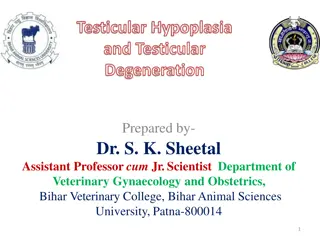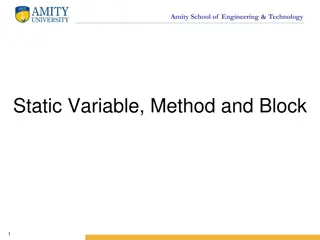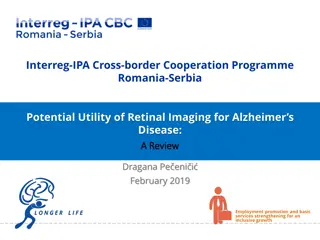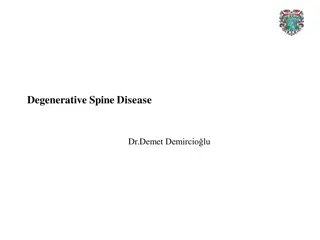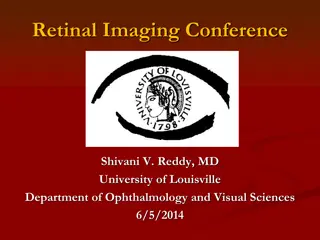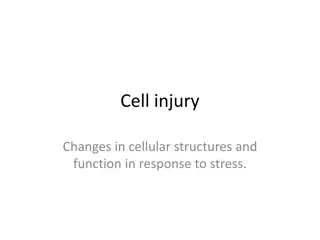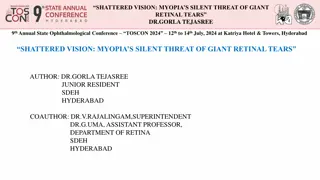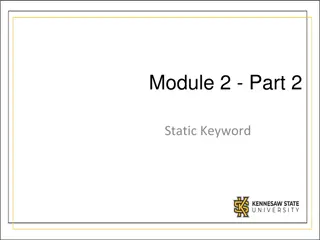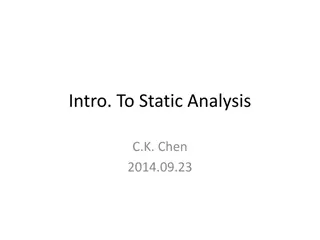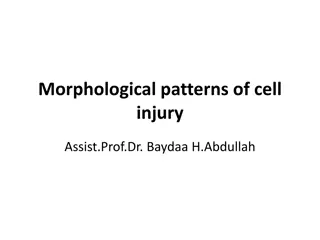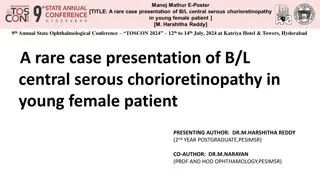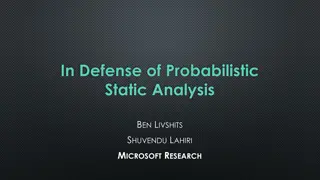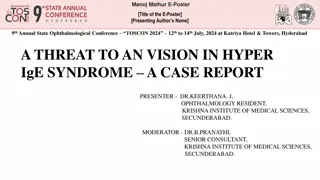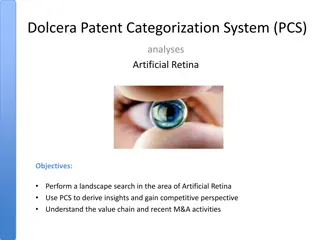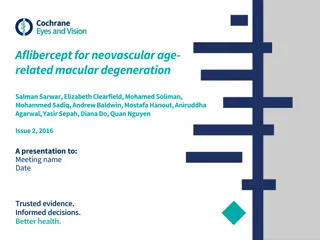Static Perimetry Rate of Progression in USH2A-Related Retinal Degeneration Study
Disease-causing variants in the USH2A gene result in Usher syndrome type 1 and non-syndromic autosomal recessive RP. This study assesses progression through static perimetry in USH2A-related retinal degeneration over two years, providing valuable insights for future clinical trials.
Download Presentation

Please find below an Image/Link to download the presentation.
The content on the website is provided AS IS for your information and personal use only. It may not be sold, licensed, or shared on other websites without obtaining consent from the author.If you encounter any issues during the download, it is possible that the publisher has removed the file from their server.
You are allowed to download the files provided on this website for personal or commercial use, subject to the condition that they are used lawfully. All files are the property of their respective owners.
The content on the website is provided AS IS for your information and personal use only. It may not be sold, licensed, or shared on other websites without obtaining consent from the author.
E N D
Presentation Transcript
Static Perimetry in the Rate of Progression in USH2A-Related Retinal Degeneration (RUSH2A) Study: Assessment Through Two Years Presented on Behalf of the Foundation Fighting Blindness Clinical Consortium Investigator Group
Background Disease-causing variants in the USH2A gene are among the most common causes of photoreceptor degeneration Biallelic variants can result in: Usher syndrome type 1 (USH2) Non-syndromic autosomal recessive RP (ARRP) Treatments for USH2A-related USH2 and ARRP have been more challenging than other autosomal recessive retinal degenerations to deliver To inform the design and interpretation of clinical trials for USH2A-related retinal degeneration, natural history studies of disease progression are essential
Background (Cont) The Rate of Progression of USH2A-related Retinal Degeneration (RUSH2A) study is a multicenter, international, longitudinal natural history study to collect data from both USH2 and ARRP patients Here we present change in static perimetry (SP) and other measures of retinal function and structure after 2 years, midway through the 4-year study period The 2-year results may help to inform interpretation of treatment trial results and shape study design of future clinical trials for patients with USH2A-related USH2 and ARRP
Methods for SP SP performed using Octopus 900 (Haag-Streit, Mason Ohio) German Adaptive Thresholding Estimation (GATE) strategy A custom centrally-condensed 186-point grid SP performed 3 times at study baseline and 1 time at each follow-up visit on better seeing eye Graded by Casey Reading Center
Static Perimetry Grids and Measures Manufactu rer s printout MSCW (dB) Center Weighted Numerical Averages all points tested in field including zeros VTOT (dB-sr) V30 (dB-sr) VPERIPH (dB-sr) 30 degree radius (60 degree solid angle) Custom RP 186-point grid VTOT - V30 Full Field Hill of Vision
Statistical Methods Entire Analysis Cohort (N=102): Study eyes that have test results for at least 2 of the 3 time points up (baseline, 1 year and 2 year) Preserved Visual Field (VF) Cohort (N=88): Study eyes from the entire analysis cohort with baseline VTOT > 5 dB-sr
Statistical Methods (Cont) Annual rates of change estimated by mixed effects models with random intercept Annual percentage rates of change estimated by modeling on log transformed data Mixed effects models applied to both the entire analysis cohort and the restricted cohort Additional models performed on the restricted cohort Excluding unreliable test results (false positive 15%, N=8) Down-weighting outlier rates of change Spearman correlation calculated among change in SP measures and with change in other visual measures
Participant Visit Flowchart Baseline: 105 Completed in the Primary Cohort 1 Patient Death Year 1 Visit: 102 Completed (11 out of +/- 4-week window) 2 Missed Year 2 Visit: 88 Completed (33 out of +/- 4-week window) 13 Remote Visit (Patient-Reported Outcome Only) 3 Missed During the COVID-19 pandemic
Baseline Characteristics (N=102) N (%) Clinical Diagnosis USH2 64 (63%) ARRP 38 (37%) Female 58 (57%) Non-Hispanic White 91 (89%) Age (yrs) Mean SD 37 13 Duration of Disease (yrs) Median (IQR) 13 (7, 20)
SP Measures at Each Visit Outcomes Baseline N= 98 a 33.1 23.5 1.5 to 90.5 N=102 10.2 5.6 1.5 to 22.7 N= 98 a 22.8 18.8 0.0 to 70.8 N= 98 a 11.7 5.8 2.4 to 24.6 Year 1 N=96 30.9 23.4 1.5 to 84.5 N=100 9.8 5.5 1.5 to 22.3 N=96 21.0 18.8 0.0 to 65.5 N=96 11.1 5.7 2.1 to 24.3 Year 2 N=85 29.0 22.6 1.5 to 87.5 N=87 9.2 5.4 1.5 to 21.8 N=85 19.7 18.1 0.0 to 66.1 N=85 10.6 5.5 2.2 to 24.6 VTOT (dB-sr) Mean SD Range V30 (dB-sr) Mean SD Range VPERIPH (dB-sr) Mean SD Range Mean Sensitivity (dB) Mean SD Range a Four participants had missing data due to wrong grid being used
Estimated Annual Rates of Change ---------------------Restricted cohort ----------------------- Entire cohort (N=102) False positives <15% (N=80) Outliers down- weighted (N=88) Outcomes VTOT (dB-sr/year) Slope Estimate 95% CI V30 (dB-sr/year) Slope Estimate 95% CI VPERIPH (dB- sr/year) Slope Estimate 95% CI Mean Sensitivity (dB/year) Slope Estimate 95% CI All (N=88) -2.05 -2.25 -2.27 -2.03 (-2.70, -1.40) (-2.96, -1.54) (-2.92, -1.62) (-2.57, -1.49) -0.48 -0.56 -0.52 -0.52 (-0.65, -0.32) (-0.73, -0.40) (-0.67, -0.37) (-0.65, -0.38) -1.53 -1.68 -1.75 -1.56 (-2.08, -0.97) (-2.29, -1.07) (-2.31, -1.18) (-2.02, -1.10) -0.55 -0.60 -0.58 -0.54 (-0.71, -0.40) (-0.77, -0.43) (-0.73, -0.43) (-0.67, -0.41)
Estimated Annual Percentage Rates of Change ---------------------Restricted cohort----------------------- False positives <15% (N=80) Entire cohort (N=102) Outliers down- weighted (N=88) Outcomes VTOT (%/year) Slope Estimate 95% CI V30 (%/year) Slope Estimate 95% CI VPERIPH (%/year) Slope Estimate 95% CI Mean Sensitivity (%/year) Slope Estimate 95% CI All (N=88) -8.3 -8.8 -8.3 -7.3 (-11.1, -5.5) (-11.7, -5.7) (-11.3, -5.2) (-9.7, -4.8) -5.2 -5.9 -5.5 -5.0 (-7.4, -3.0) (-7.9, -4.0) (-7.4, -3.5) (-6.8, -3.3) -16.0 -13.6 -13.2 -9.7 (-22.0, -9.5) (-19.2, -7.7) (-19.1, -6.9) (-13.7, -5.5) -5.1 -5.4 -5.1 -4.9 (-6.7, -3.5) (-7.1, -3.7) (-6.8, -3.4) (-6.3, -3.5)
Spearman Correlation Coefficients (95% CI) Among Change in SP Measures SP Mean sensitivity VTOT V30 Vperiph VTOT, dB-sr 1.00 V30, dB-sr 0.66 1.00 (0.52, 0.77) 0.98 (0.96, 0.98) 0.86 (0.79, 0.91) VPERIPH, dB-sr 0.52 1.00 (0.35, 0.66) 0.91 (0.87, 0.94) SP Mean sensitivity, dB 0.76 1.00 (0.66, 0.84)
Spearman Correlation Coefficients (95% CI) Change in SP Measures vs Other Visual Measures SP Mean sensitivity 0.07 (-0.15, 0.28) 0.10 (-0.15, 0.34) 0.04 (-0.21, 0.28) 0.09 (-0.16, 0.33) 0.19 (-0.05, 0.41) VTOT V30 Vperiph BCVA, letters 0.12 0.06 0.12 (-0.09, 0.33) 0.11 (-0.14, 0.35) -0.02 (-0.27, 0.23) 0.14 (-0.11, 0.38) 0.12 (-0.12, 0.35) (-0.15, 0.27) -0.10 (-0.15, 0.33) 0.07 (-0.17, 0.31) 0.07 (-0.18, 0.31) 0.25 (0.02, 0.46) (-0.09, 0.33) 0.05 (-0.20, 0.29) -0.07 (-0.31, 0.18) 0.11 (-0.14, 0.35) 0.08 (-0.16, 0.32) FST white, -dB FST blue, -dB FST red, -dB Microperimety Mean sensitivity, dB
Spearman Correlation Coefficients (95% CI) Change in SP vs Other Visual Measures SP Mean sensitivity 0.38 VTOT V30 Vperiph 0.28 0.40 0.24 OCT Ellipsoid zone area, mm2 (0.07, 0.47) 0.38 (0.21, 0.57) 0.24 (0.02, 0.43) 0.40 (0.18, 0.55) 0.34 OCT CST (no CME), microns (0.09, 0.62) (-0.06, 0.50) (0.10, 0.62) (0.04, 0.59)
Summary of Results RUSH2A visual field measures showed significant change over 24 months The greatest annual rates of change were observed in VTOT and VPERIPH The lowest annual rates of change were in V30 and Mean Sensitivity
Discussion VTOT and VPERIPH Side vision lost earliest in USH2A-related retinal degeneration Regions where rods are predominant More prone to change V30 and Mean Sensitivity Central vision preserved longest in USH2A-related retinal degeneration Regions where cones are predominant Less prone to change
Challenges Substantial inter-individual variability in progressive VF loss over 2 years Low follow-up completion rate at 24M: N=105 at baseline N= only 88 with limited follow up during COVID-19 pandemic
Conclusions Significant rates of decline in all 4 SP metrics (VTOT, VPERIPH, V30 and Mean Sensitivity) over 24 months Strong internal correlation among SP measures Mild correlation with OCT EZ area and CST (and V30 with MP) 4 Year data will be helpful (improve signal to noise less variability around estimates of rates of change)
Acknowledgements Foundation Fighting Blindness Clinical Consortium Writing Committee Jacque L. Duncan Peiyao Cheng Maureen G. Maguire Allison A. Ayala David G. Birch Janet K. Cheetham Todd A. Durham Abigail T. Fahim Carel B. Hoyng Hiroshi Ishikawa Michel Michaelides Mark E. Pennesi Jos -Alain Sahel Katarina Stingl Christina Y. Weng --For the FFB Clinical Consortium Investigator Group
